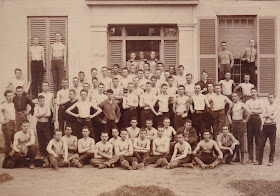 |
| Spectators Watching Cane Rush |
Cane rush is one of a number of rushes that have come and gone in the history of the College. These rushes (different from rushing a fraternity) usually involved the physical removal or capture of some item or items. The competitions usually took place between the freshman and sophomore classes.
 |
| Members of the Class of 1886 following the Cane Rush of 1883 against the Class of 1887 |
For cane rush, freshmen would appear in a prominent place, often at chapel, carrying canes. The sophomores would then respond en masse trying to remove the canes from the freshmen. As with football rush, this was not a gentle competition and usually resulted in damage to property and persons. Cane rush was banned by the Faculty on several occasions, but this had little effect and the tradition appears to have carried on into the early-20th century.
 |
| A piece of a cane removed from a member of the Class of 1885 |
No comments:
Post a Comment